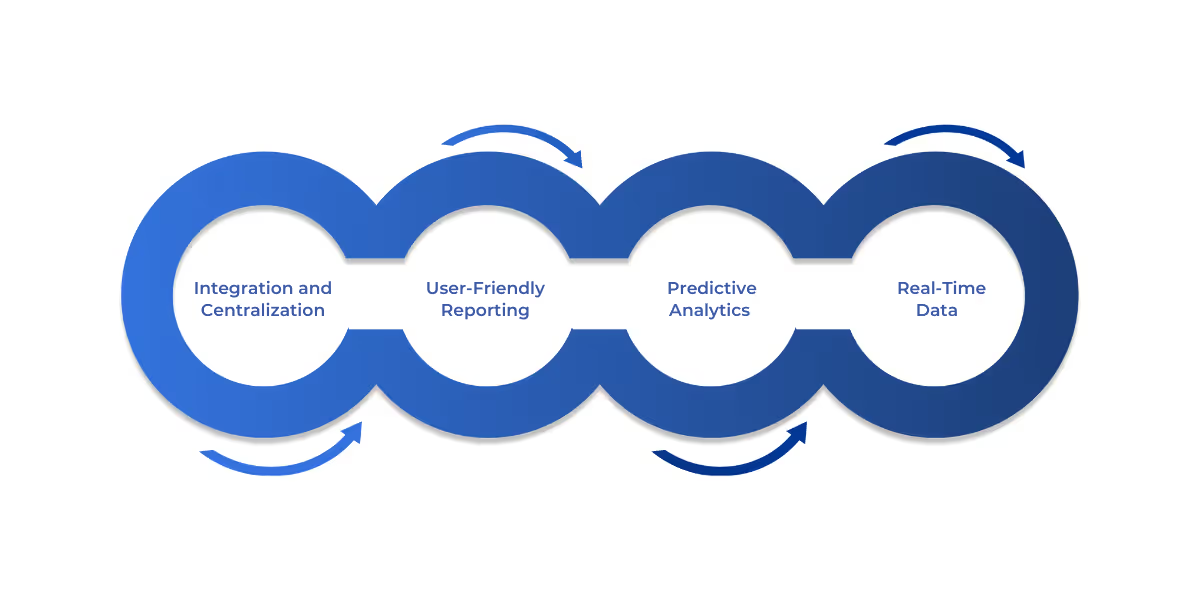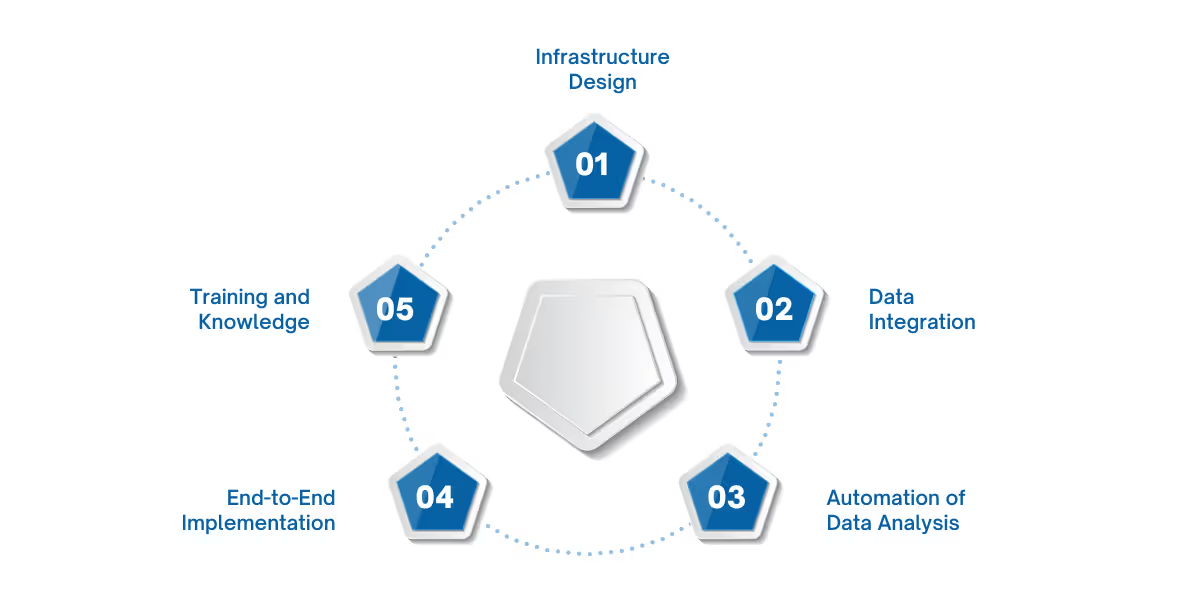

Microsoft Fabric Analytics helps small businesses centralize data from various sources, enabling informed, data-driven decisions. It provides easy access to powerful analytics tools, reporting, and predictive insights, improving operational efficiency and customer engagement.

Microsoft Fabric Analytics provides essential features designed to help small businesses manage data and gain actionable insights.
1. Data Integration and Centralization
Fabric Analytics consolidates data from various sources, including cloud services, spreadsheets, and databases, into a single platform. This centralization ensures accurate and quick access to all relevant data for analysis.
2. Scalable and User-Friendly Reporting
Small businesses can generate customizable reports on KPIs such as sales, expenses, and customer behavior without needing advanced technical expertise.
The platform is intuitive, with drag-and-drop features for easy report creation.
3. Predictive Analytics for Business Forecasting
Utilizing AI and machine learning, Fabric Analytics predicts future trends by analyzing historical data. These predictions allow businesses to make proactive decisions in inventory management, customer retention, and financial planning.
4. Real-Time Data Visualization
Real-time dashboards show critical metrics, enabling businesses to monitor operations and quickly identify issues or opportunities.
Once the benefits are clear, it’s essential to understand how to implement Microsoft Fabric Analytics effectively.
Also Read: Introduction to Microsoft Fabric for Small and Medium-Sized Enterprises
Implementing Microsoft Fabric Analytics involves integrating it with current systems, customizing it to meet specific business needs, and ensuring employees are trained to use the platform effectively.
1. Steps to Integrate Fabric Analytics into Small Business Operations
2. Customizing Fabric Analytics to Align with Business Goals
Customize data models, reports, and dashboards to focus on business goals such as customer retention, cost reduction, and revenue growth. Small businesses can collaborate with data experts to adjust the platform to their needs.
3. Training and Support for Small Businesses
Microsoft offers training materials, tutorials, and webinars to help businesses get the most out of Fabric Analytics. Support plans are also available for troubleshooting and advanced customization.

Microsoft Fabric Analytics improves decision-making by automating data analysis through AI-powered algorithms, providing predictive insights and allowing businesses to make faster, more informed decisions.
With features like centralized data integration, automated analysis, and scenario modeling, small businesses can optimize operations, reduce risks, and drive growth.
Here’s how it works:
Also Read: Simple Guide to Data Infrastructure and Analytics
To assess the effectiveness of Microsoft Fabric, let’s dive into how it impacts business growth and productivity metrics
Microsoft Fabric Analytics enables small businesses to track key metrics that measure productivity, cost savings, and growth. By automating processes like inventory management it reduces stockouts, waste, and operational costs.
For instance, a small online retailer using Fabric Analytics saw a 20% increase in revenue, 15% improvement in customer retention, and 10% growth in new customers within six months.
The platform’s predictive insights helped optimize inventory, refine marketing, and boost sales, leading to sustained growth.
While the benefits of analytics are clear, small businesses often face challenges when implementing such solutions. Let’s discuss how Microsoft Fabric addresses these obstacles.
SMBs often face barriers like complexity, high costs, and a lack of technical expertise when adopting analytics solutions. Microsoft Fabric addresses these challenges by providing an all-in-one solution that simplifies analytics at every stage.
To ensure successful adoption, it’s crucial to have the right support. Here’s how WaferWire can assist your business in implementing and optimizing Microsoft Fabric Analytics.

WaferWire Cloud Technologies helps small businesses effectively implement and optimize Microsoft Fabric Analytics with the following services:
1. Cloud Infrastructure Design
We design and deploy cloud solutions that integrate Microsoft Fabric seamlessly into your existing systems, ensuring scalability and optimal performance.
2. Data Integration and Centralization
We help centralize data from various sources into Microsoft Fabric, providing consistent, real-time insights that improve decision-making and business operations.
3. Automation of Data Analysis
We streamline data processing and reporting to save time and reduce manual effort, allowing you to focus on critical business decisions.
4. End-to-End Implementation and Support
We manage the entire process, from initial strategy to deployment and ongoing support, ensuring Microsoft Fabric works smoothly for your business.
5. Training and Knowledge Transfer
We provide hands-on training, ensuring your team is equipped to fully utilize Microsoft Fabric Analytics for reporting, forecasting, and decision-making.
WaferWire simplifies the adoption of Microsoft Fabric Analytics, ensuring you get the most value out of your data to enhance business growth and efficiency.
Integrating Microsoft Fabric Analytics into your business improves data management, enhances decision-making, and increases efficiency. By centralizing data and automating processes, businesses can make faster and more informed decisions.
However, successful implementation is just the beginning. Ongoing optimization and integration with other tools are key to fully realizing its potential.
At WaferWire, we help businesses of various sizes integrate, optimize, and customize Microsoft Fabric Analytics. From setup and data integration to custom models and support, we ensure you maximize the value of your investment. Contact WaferWire today to drive your business success.
Q: How does Microsoft Fabric Analytics help small businesses improve their operations?
A: Microsoft Fabric Analytics centralizes data, automates reporting, and provides predictive insights, helping small businesses streamline processes, make data-driven decisions, and improve overall efficiency.
Q: Is Microsoft Fabric Analytics suitable for businesses without a dedicated IT team?
A: Yes, the platform is designed to be user-friendly with features like drag-and-drop reporting and low-code tools, making it accessible for businesses without a dedicated IT team.
Q: How does predictive analytics in Microsoft Fabric benefit small businesses?
A: Predictive analytics helps small businesses forecast future trends based on historical data, enabling proactive decision-making in areas like inventory management, customer retention, and financial planning.
Q: Can Microsoft Fabric Analytics integrate with existing software tools?
A: Yes, Microsoft Fabric integrates easily with other software tools like CRM systems, accounting software, and eCommerce platforms, allowing businesses to consolidate their data in one place.
Q: What kind of ongoing support is available for small businesses using Microsoft Fabric Analytics?
A: Microsoft provides comprehensive support resources, including training, webinars, and troubleshooting, ensuring businesses can maximize the value of Fabric Analytics long-term.

